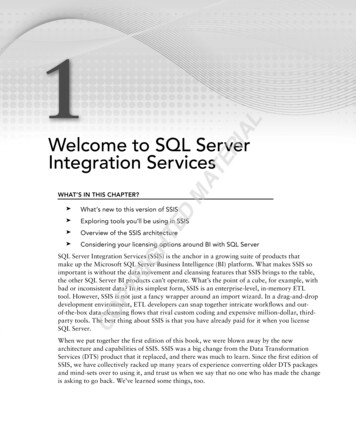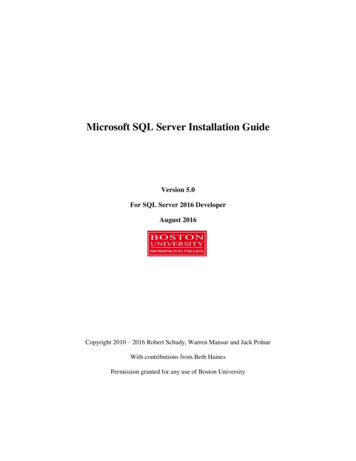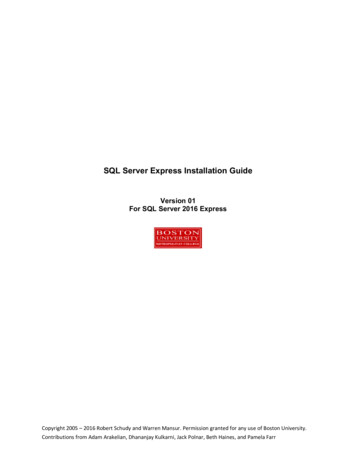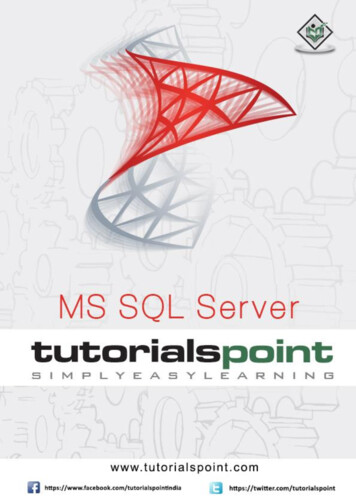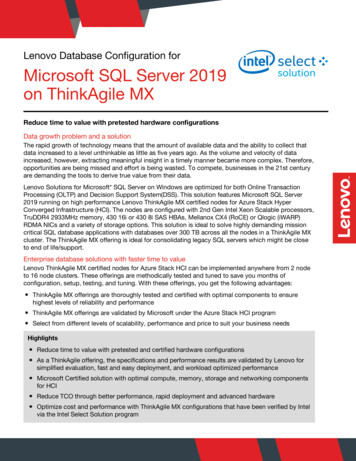![[MS-DPSSAS]: SQL Server Analysis Services Data Portability .](/img/15/5bms-dpssas-5d-140520.jpg)
Transcription
[MS-DPSSAS]:SQL Server Analysis Services Data Portability OverviewIntellectual Property Rights Notice for Open Specifications Documentation Technical Documentation. Microsoft publishes Open Specifications documentation forprotocols, file formats, languages, standards as well as overviews of the interaction among eachof these technologies. Copyrights. This documentation is covered by Microsoft copyrights. Regardless of any otherterms that are contained in the terms of use for the Microsoft website that hosts thisdocumentation, you may make copies of it in order to develop implementations of thetechnologies described in the Open Specifications and may distribute portions of it in yourimplementations using these technologies or your documentation as necessary to properlydocument the implementation. You may also distribute in your implementation, with or withoutmodification, any schema, IDL’s, or code samples that are included in the documentation. Thispermission also applies to any documents that are referenced in the Open Specifications. No Trade Secrets. Microsoft does not claim any trade secret rights in this documentation. Patents. Microsoft has patents that may cover your implementations of the technologiesdescribed in the Open Specifications. Neither this notice nor Microsoft's delivery of thedocumentation grants any licenses under those or any other Microsoft patents. However, a givenOpen Specification may be covered by Microsoft Open Specification Promise or the CommunityPromise. If you would prefer a written license, or if the technologies described in the OpenSpecifications are not covered by the Open Specifications Promise or Community Promise, asapplicable, patent licenses are available by contacting iplg@microsoft.com. Trademarks. The names of companies and products contained in this documentation may becovered by trademarks or similar intellectual property rights. This notice does not grant anylicenses under those rights. For a list of Microsoft trademarks, visitwww.microsoft.com/trademarks. Fictitious Names. The example companies, organizations, products, domain names, emailaddresses, logos, people, places, and events depicted in this documentation are fictitious. Noassociation with any real company, organization, product, domain name, email address, logo,person, place, or event is intended or should be inferred.Reservation of Rights. All other rights are reserved, and this notice does not grant any rightsother than specifically described above, whether by implication, estoppel, or otherwise.Tools. The Open Specifications do not require the use of Microsoft programming tools orprogramming environments in order for you to develop an implementation. If you have access toMicrosoft programming tools and environments you are free to take advantage of them. CertainOpen Specifications are intended for use in conjunction with publicly available standardspecifications and network programming art, and assumes that the reader either is familiar with theaforementioned material or has immediate access to it.1 / 13[MS-DPSSAS] — v20140520SQL Server Analysis Services Data Portability OverviewCopyright 2014 Microsoft Corporation.Release: Tuesday, May 20, 2014
Revision 04/20100.1MajorFirst release.09/03/20100.1No changeNo changes to the meaning, language, or formatting ofthe technical content.02/09/20110.1No changeNo changes to the meaning, language, or formatting ofthe technical content.07/07/20110.1No changeNo changes to the meaning, language, or formatting ofthe technical content.11/03/20110.1No changeNo changes to the meaning, language, or formatting ofthe technical content.01/19/20121.1MinorClarified the meaning of the technical content.02/23/20121.1No changeNo changes to the meaning, language, or formatting ofthe technical content.03/27/20121.1No changeNo changes to the meaning, language, or formatting ofthe technical content.05/24/20121.1No changeNo changes to the meaning, language, or formatting ofthe technical content.06/29/20121.1No changeNo changes to the meaning, language, or formatting ofthe technical content.07/16/20121.1No changeNo changes to the meaning, language, or formatting ofthe technical content.10/08/20121.1No changeNo changes to the meaning, language, or formatting ofthe technical content.10/23/20121.1No changeNo changes to the meaning, language, or formatting ofthe technical content.03/26/20131.1No changeNo changes to the meaning, language, or formatting ofthe technical content.06/11/20131.1No changeNo changes to the meaning, language, or formatting ofthe technical content.08/08/20131.1No changeNo changes to the meaning, language, or formatting ofthe technical content.12/05/20131.1No changeNo changes to the meaning, language, or formatting ofthe technical content.02/11/20141.1No changeNo changes to the meaning, language, or formatting ofthe technical content.2 / 13[MS-DPSSAS] — v20140520SQL Server Analysis Services Data Portability OverviewCopyright 2014 Microsoft Corporation.Release: Tuesday, May 20, 2014
DateRevisionHistoryRevisionClass05/20/20141.1No changeCommentsNo changes to the meaning, language, or formatting ofthe technical content.3 / 13[MS-DPSSAS] — v20140520SQL Server Analysis Services Data Portability OverviewCopyright 2014 Microsoft Corporation.Release: Tuesday, May 20, 2014
Contents1Introduction . 51.1 Glossary . 51.2 References . 52Data Portability Scenarios . 72.1 Exporting Metadata . 72.1.1 Data Description . 72.1.1.1 Unified Dimensional Model . 72.1.1.2 Data Mining . 82.1.2 Format and Protocol Summary . 82.1.3 Data Portability Methodology . 82.1.3.1 Using Microsoft SQL Server Management Studio . 82.1.3.2 Using Analysis Management Objects . 92.1.3.3 Preconditions . 92.1.3.4 Versioning . 92.1.3.5 Error Handling . 92.1.3.6 Coherency Requirements . 92.1.3.7 Additional Considerations. 92.1.3.7.1 Data Source Connection String . 102.2 Exporting Writeback Data . 102.2.1 Data Description . 102.2.1.1 Dimension Writeback . 102.2.1.2 Cube and Partition Writeback . 102.2.2 Format and Protocol Summary . 102.2.3 Data Portability Methodology . 112.2.3.1 Preconditions . 112.2.3.2 Versioning . 112.2.3.3 Error Handling . 112.2.3.4 Coherency Requirements . 112.2.3.5 Additional Considerations. 113Change Tracking. 124Index . 134 / 13[MS-DPSSAS] — v20140520SQL Server Analysis Services Data Portability OverviewCopyright 2014 Microsoft Corporation.Release: Tuesday, May 20, 2014
1IntroductionThe SQL Server Analysis Services Data Portability Overview document provides an overview of dataportability scenarios between SQL Server Analysis Services and a vendor’s application. AnalysisServices provides a business intelligence (BI) platform that enables end users and IT professionalsto efficiently analyze business data.Two primary workloads exist for achieving this: Corporate BI: In this mode, IT professionals use Business Intelligence Development Studio andMicrosoft SQL Server Management Studio to build and manage Analysis Services installations. Self-Service BI: In this mode, end users build their own solutions by using PowerPivottechnologies.In either mode, Analysis Services databases are built and used by the client tools. Unless specifiedotherwise, concepts and mechanisms described in this document are applicable to both workloads.1.1GlossaryThe following terms are defined in [MS-OFCGLOS]:cubeThe following terms are defined in [MS-SSAS]:analysis CGLOS] Microsoft Corporation, "Microsoft Office Master Glossary".[MS-SSAS] Microsoft Corporation, "SQL Server Analysis Services Protocol".[MSDN-AMO] Microsoft Corporation, "Developing with Analysis Management Objects 24924.aspx[MSDN-BIDS] Microsoft Corporation, "Introducing Business Intelligence Development 173767.aspx[MSDN-PROC] Microsoft Corporation, "Analysis Services 2005 Processing ary/ms345142(SQL.90).aspx[MSDN-SSMS] Microsoft Corporation, "Use SQL Server Management 174173.aspx[MSDN-UDM] Microsoft Corporation, "Unified Dimensional Model", L.90).aspx[MSFT-DM] Microsoft Corporation, "Data Mining Concepts", .aspx[MSFT-WBDIM] Microsoft Corporation, "Write-Enabled rary/ms174540.aspx5 / 13[MS-DPSSAS] — v20140520SQL Server Analysis Services Data Portability OverviewCopyright 2014 Microsoft Corporation.Release: Tuesday, May 20, 2014
[MSFT-WBPT] Microsoft Corporation, "Write-Enabled Partitions", .aspx6 / 13[MS-DPSSAS] — v20140520SQL Server Analysis Services Data Portability OverviewCopyright 2014 Microsoft Corporation.Release: Tuesday, May 20, 2014
2Data Portability ScenariosAnalysis Services imports data from a variety of data sources and makes this data available foranalysis by end users. Analysis Services architecture is designed with the assumption that theunderlying data source is the master store of this data. This assumption holds for data pushed toAnalysis Services through a mechanism called push-mode processing. For more information aboutpush-mode processing, see [MSDN-PROC]. As such, Analysis Services does not provide an efficientbulk data export utility and instead depends on the capabilities of the underlying data source for thispurpose.At the same time, Analysis Services provides support for exporting the definition of objects definedby IT professionals. In addition, Analysis Services enables end users to write data back into AnalysisServices. This section describes how to export this data.2.1Exporting MetadataThird-party applications can export definitions of user-created objects stored within AnalysisServices.2.1.1Data Description2.1.1.1Unified Dimensional ModelThe Analysis Services metadata model, called a Unified Dimensional Model (UDM), provides a bridgebetween users and the data sources. A UDM is constructed over one or more physical data sources,and it allows end-user queries using one of a variety of client tools, such as Microsoft Office Excel.Figure 1: Unified Dimensional ModelA UDM contains information about: Data source connections. A schema snapshot for data that exists in a data source. The user-visible concepts, such as dimensions, hierarchies, and key performance indicators. Mapping between the user-visible concepts and the underlying data sources.7 / 13[MS-DPSSAS] — v20140520SQL Server Analysis Services Data Portability OverviewCopyright 2014 Microsoft Corporation.Release: Tuesday, May 20, 2014
Calculations that encapsulate business logic, such as a three-month moving average. Security roles and associated authorizations.For more information about the UDM, see [MSDN-UDM].A UDM is typically defined by IT professionals using Business Intelligence Development Studio.During the development process, UDM metadata is stored in proprietary XML-based files. Once thisUDM definition is complete, it can be deployed by Business Intelligence Development Studio to ananalysis server by using the SQL Server Analysis Services Protocol [MS-SSAS] where it is stored ina proprietary format. For more information about Business Intelligence Development Studio, see[MSDN-BIDS].2.1.1.2Data MiningData mining is the process of discovering actionable information from data by using variousmathematical analysis techniques. Analysis Services provides data mining support. Within AnalysisServices, data mining information is specified as part of a database. For more information aboutdata mining, see [MSFT-DM].Client tools use the SQL Server Analysis Services Protocol [MS-SSAS] for communicating with bothUDM and data mining on an analysis server.2.1.2Format and Protocol SummaryThe following table provides a comprehensive list of the formats and protocols used in this dataportability scenario.Protocol or formatnameDescriptionReferenceSQL Server AnalysisServices ProtocolSpecifies methods for a client to communicate with, andperform operations on, an analysis server.[MSSSAS]2.1.3Data Portability Methodology2.1.3.1Using Microsoft SQL Server Management StudioMicrosoft SQL Server Management Studio allows implementers to manage instances of AnalysisService servers. For more information about SQL Server Management Studio, see [MSDN-SSMS].To extract metadata by using SQL Server Management Studio, follow these steps:1. Connect to Analysis Services. For Analysis Services servers in multidimensional mode, please connect to the database byproviding the server name or servername\instancename. For PowerPivot workbooks, upload the PowerPivot workbook to a Microsoft PowerPivot forSharePoint server. Connect to the database by providing the URL of the PowerPivot workbookon the Microsoft SharePoint server. For Tabular projects in Business Intelligence Development Studio, deploy the Tabular Project toAnalysis Services running in Tabular mode. Connect to the database by providing the servername or servername\instance name.8 / 13[MS-DPSSAS] — v20140520SQL Server Analysis Services Data Portability OverviewCopyright 2014 Microsoft Corporation.Release: Tuesday, May 20, 2014
2. Select the database to be scripted. In the case of PowerPivot workbooks, you only have a singledatabase.3. Right-click the database object to see the context menu, and then select Script Database as.4. Retrieve the script to create the database. To do this, select CREATE To, and then specify thedestination of the script.The output of these steps results in XML content that contains all metadata objects within thedatabase and that conforms to the XML Schema definition language (XSD) documented in [MSSSAS].2.1.3.2Using Analysis Management ObjectsThe Analysis Management Objects (AMO) object model enables implementers to programmaticallymanage a running instance of an Analysis Services database. For more information about AMO, see[MSDN-AMO].To extract metadata by using AMO, follow these steps:1. Use the Server.Connect() method to connect to Analysis Services.2. Initialize a System.Xml.XmlWriter instance, such as System.Xml.XmlTextWriter.3. Use the Server.Connect() method to connect to Analysis Services.4. Flush and close the System.Xml.XmlWriter instance.The output of these steps results in XML content that contains all metadata objects within thedatabase and that conforms to the XSD language documented in [MS-SSAS].2.1.3.3PreconditionsTo extract the metadata from an Analysis Services database, an Analysis Services server must havethe database loaded, and this database must be accessible to the security principal executing theextraction commands.2.1.3.4VersioningNone.2.1.3.5Error HandlingNone.2.1.3.6Coherency RequirementsThere are no special coherency requirements.2.1.3.7Additional ConsiderationsThere are no additional considerations.9 / 13[MS-DPSSAS] — v20140520SQL Server Analysis Services Data Portability OverviewCopyright 2014 Microsoft Corporation.Release: Tuesday, May 20, 2014
2.1.3.7.1Data Source Connection StringBecause of security considerations, any explicit password that is specified in data source connectionstrings that are sent to Analysis Services cannot be retrieved and must be respecified.2.2Exporting Writeback DataCertain Analysis Services deployments enable interactive updates to dimensions and partition data.Writeback features are supported only in Corporate BI mode and are not supported in Self-ServiceBI mode.2.2.1Data Description2.2.1.1Dimension WritebackDimension writebacks allow implementers to change, move, add, and delete attribute memberswithin a dimension. These updates are stored directly in the data source table, which serves as thesource for the dimension. For exporting this data, applications can query the underlying data sourcedirectly.For more information about dimension writeback, see [MSFT-WBDIM].2.2.1.2Cube and Partition WritebackCube writebacks enable implementers to change measure data that is stored in a partition.Once an implementer enables a cube for writeback through Business Intelligence DevelopmentStudio, Analysis Services performs the following operations: Creates a writeback table in the underlying data source that stores changes made by the enduser as a difference from the current value. For example, if an end user changes a cell value from90 to 100, the value 10 is stored in the writeback table, along with the time of the change andinformation about the end user who made the change. Creates a writeback partition within the cube that corresponds to the writeback table.The net effect of accumulated changes is displayed to client applications. The original value in thecube is preserved, and an audit trail of changes is recorded in the writeback table.For more information about write-enabled partitions, see [MSFT-WBPT].2.2.2Format and Protocol SummaryThe following table provides a comprehensive list of the formats and protocols used in this dataportability scenario.Protocol or formatnameDescriptionReferenceSQL Server AnalysisServices ProtocolSpecifies methods for a client to communicate with, andperform operations on, an analysis server.[MSSSAS]10 / 13[MS-DPSSAS] — v20140520SQL Server Analysis Services Data Portability OverviewCopyright 2014 Microsoft Corporation.Release: Tuesday, May 20, 2014
2.2.3Data Portability MethodologyWriteback partitions can be identified through SQL Server Analysis Services Protocol [MS-SSAS] orthrough AMO [MSDN-AMO]. In SQL Server Analysis Services Protocol, writeback partitions are Partition elements that havetheir Type element set to Writeback. In AMO, writeback partitions are objects of type Partition that have their Type property set toPartitionType.Writeback.Because the data source bindings of a writeback partition are similar to those of a regular partition,information about the table that is used for storing writeback data can be retrieved through theSource property of the writeback partition. In the TableBinding type, the table name is stored inthe DbTableName property.2.2.3.1PreconditionsTo retrieve information about writeback partitions, the partitions must be accessible on an AnalysisServices server by the security principal issuing discovery commands.2.2.3.2VersioningNone.2.2.3.3Error HandlingNone.2.2.3.4Coherency RequirementsThere are no special coherency requirements.2.2.3.5Additional ConsiderationsThere are no additional considerations.11 / 13[MS-DPSSAS] — v20140520SQL Server Analysis Services Data Portability OverviewCopyright 2014 Microsoft Corporation.Release: Tuesday, May 20, 2014
3Change TrackingNo table of changes is available. The document is either new or has had no changes since its lastrelease.12 / 13[MS-DPSSAS] — v20140520SQL Server Analysis Services Data Portability OverviewCopyright 2014 Microsoft Corporation.Release: Tuesday, May 20, 2014
4IndexCChange tracking 12GGlossary 5RReferences 5TTracking changes 1213 / 13[MS-DPSSAS] — v20140520SQL Server Analysis Services Data Portability OverviewCopyright 2014 Microsoft Corporation.Release: Tuesday, May 20, 2014
Release: Tuesday, May 20, 2014 1 Introduction The SQL Server Analysis Services Data Portability Overview document provides an overview of data portability scenarios between SQL Server Analysis Services and a vendor’s application. Analysis Services provides a business intelligence





